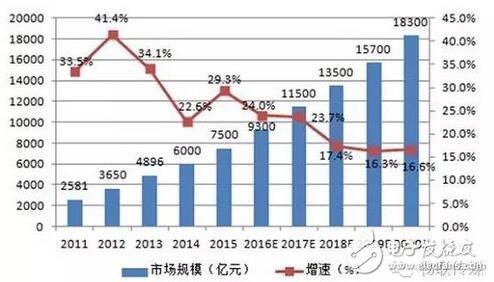According to the data of the Ministry of Industry and Information Technology, the scale of China's Internet of Things industry reached 600 billion yuan in 2014, a year-on-year increase of 22.6%. In 2015, the industry scale reached 750 billion yuan, a year-on-year increase of 29.3%. It is estimated that by 2020, the overall size of China's Internet of Things will exceed 1.8 trillion yuan. Facing the huge market prospect of the Internet of Things, China Telecom, China Unicom and China Mobile, the three major operators in China, are constantly undergoing transformation in order to have more voice in the Internet of Things era. China Telecom: Cloud, network, and all levels open up to form a chain for application scenarios In 2016, China Telecom's IOT strategy was re-adjusted. China Telecom regards the Internet of Things as an independent network operation, providing a dedicated network, a dedicated platform, a dedicated number card, exclusive tariffs and professional support to provide users with a more independent and more secure service. The obvious feature of the Internet of Things is that each of its application scenarios is separate. The solution for different applications, such as chip, terminal, network and cloud, is different. Telecommunications will open up all levels of the cloud, network and terminals to form an application scenario service for the entire chain. Therefore, the most important task of the current telecommunications is to focus on the connection, do the basic pipeline service, and then exert the power on the IOT platform. Finally, the infrastructure is perfected and the vertical application providers jointly develop and operate the Internet of Things application service. For the network side, telecommunications continues to promote network evolution and provide high-quality connectivity according to the needs of different application scenarios of the Internet of Things. Wireless short-range connection: WiFi, Bluetooth, Zigbee, DSRC; wireless long-distance connection: 2G/3G/4G/NB-IoT/LoRa; fixed network connection: PON, Ethernet, serial port and satellite connection: still track, low track, etc. . In the China Telecom 2025 white paper announced in July, telecommunications will achieve a transformation of the network, and the network will become more flexible in the next 5-10 years, and more capabilities will be opened up. For the terminal, China Telecom cooperates with the module and communication equipment manufacturers to promote the evolution of the mobile communication network and prepare for a richer application scenario. In the future, 60%-70% of applications will account for the low-rate and low-power consumption. Therefore, telecom will gradually promote the maturity of NB-IoT with module vendors. Next year, combined with the completion of telecom 800M frequency re-cultivation, a larger area coverage will be carried out. In addition, telecommunications through the IoT platform to promote industrial ecological convergence. Telecommunications mainly serves two platforms: the underlying connection management platform, which provides better management services for network connections, and enables the platform to have the functions of diagnosis, perception, management and control. The upper-level business enablement platform helps customers to support application development, and the business enablement platform realizes through application. As the IoT scenario will inevitably generate a large amount of data accumulation, Telecom hopes to use this data to do more business innovation. Telecom has IDC resources, cloud computing, and cloud storage provide the foundation for big data applications. For the industry, the main focus is on three types of products, six major industries. Three types of products: solutions for key industry benchmark customers; functional application platform; channel connection. The six major industries mainly include public utilities (water and electricity meters, mobile pos, etc.), intelligent transportation, energy manufacturing, smart logistics, security monitoring, and smart medical care. China Unicom: Building five major capabilities of China Unicom's four major products In the entire application plan, China Unicom has four major products in terms of product layout. The first of the four products is the carrier's traditional products, connected services, including the network, as well as connection management and equipment management for the network. Followed by M2M application services; then M2M component services, and finally M2M solution integration. At the same time, we must build five capabilities: The first is the M2M platform capability, which includes the connection management capabilities for the network and terminal devices, and the support capabilities for building applications on the M2M platform. The other four capabilities are: application service resource aggregation capability, terminal module customization capability, end-to-end solution integration capability, and globalization capability. In terms of the whole system, China Unicom has built a globally integrated, flat support and service system for the Internet of Things. China Unicom focuses on the business of the IoT platform, mainly involving the government, transportation, energy and utilities, manufacturing, health, commercial retail, and automotive services. Hotspots include: car networking, mobile payments, smart watches, smart wearables, mobile media, industrial and environmental monitoring, etc., providing users with an end-to-end total solution. Grinder Machine,Surface Grinding Machine,Grinding Equipment,Tool Grinding Machine Hunan Furui Mechanical and Electrical Equipment Manufacturing Co., Ltd. , https://www.thresher.nl